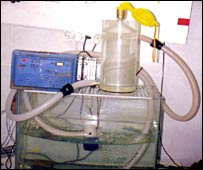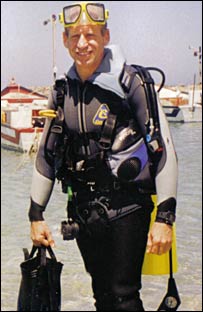http://news.bbc.co.uk/1/hi/sci/tech/4665624.stm
Inventor develops 'artificial gills'
By Lakshmi Sandhana

 The system currently exists as a laboratory model
The system currently exists as a laboratory model
An Israeli inventor has developed an underwater breathing system that literally squeezes oxygen directly from seawater, doing away with the need for compressed air tanks.
Called "LikeAFish", the battery-powered artificial gill system aims to extract the small amounts of dissolved air that already exists in water to supply breathable oxygen to scuba divers, submarines and underwater habitats.
The device is the brainchild of Alon Bodner.
It utilises a high-speed centrifuge to lower the pressure of seawater in a small sealed chamber.
This allows the dissolved air to escape back into a gaseous state - much like the way carbon dioxide is liberated from a soft drink when you reduce the pressure on it by popping the bottle cap.
The air thus liberated is then transferred to an airbag for the diver to use.
Since every litre of water contains about 1.5% of dissolved air, Bodner's system must circulate around 200 litres of water per minute to accommodate the breathing needs of an average person.
Instead of being restricted to the amount of air that can be carried in a tank, a diver's air supply would then depend only on the battery power available.
Prototype development
"For a closed-circuit system, the diver would need to pump approximately 200 Litres-per-minute (LPM) of water under ideal conditions, to separate one LPM of oxygen, which a diver needs," Bodner told the BBC News website.
"A one-kilo battery should be able to supply a diver with one hour of dive time."
Right now, the system exists as a laboratory model with European patents approved and US applications pending.
Currently, Bodner is engaged in outfitting an underwater habitat in Australia with the system.
He eventually plans to reduce the size of the apparatus, taking it down to a small, lightweight vest for divers; and estimates that a fully functional prototype is about two years away.
Though it promises to be a revolutionary new technology, experts share a number of concerns.
Hard work
"Bodner makes the assumption that a closed-circuit re-breather diver will use one litre of oxygen per minute," says Mike Rowley, a British Sub-Aqua Club (BSAC) National Instructor.
"However, this is by no means an absolute figure; it's based upon an average male adult engaged in light underwater swimming. With work (such as heavy swimming against a strong current), this figure can rise to at least 3.5 litres per minute.
 Bodner believes his system would work well in the right setting
Bodner believes his system would work well in the right setting
"If we assume for the moment that his other assumptions are correct, the machine is going to have to have some form of reserve capacity to enable it to cope with lengthy periods of high oxygen metabolism.
"To do this, it will need some form of reserve or some means of increasing the flow of water, which in turn will need a larger centrifuge capacity. Both of these consequences will have the effect of increasing the power requirement."
In addition to limits that might potentially exist in pumping, the concentration of oxygen in water also varies.
"Dead zones" in lakes and oceans contain less dissolved oxygen, and what happens when the water contains contaminants or is heavily polluted?
"I wouldn't adopt this new technology, as it introduces uncertainty over the oxygen supply when I could have a very reliable cylinder which I filled before hand," said Craig Billingham, a technical diver/instructor with over 15 years of diving experience.
Greatest potential
For closed systems, the diver re-breathes the air again and again, after the carbon dioxide (CO2) is scrubbed. Currently dive times are not limited by the amount of gas that can be carried but by how long the CO2 scrubber works, which is typically 3 hours.
"LikeAFish misses the point, as he is trying to eliminate the need to carry cylinders," said Billingham.
"The limit of the equipment is still the scrubber, not the gas supply. So I would take a cylinder; it doesn't need batteries and will last 10 hours anyway, whereas you will need a lot of batteries to get the equivalent time.
"Also batteries and seawater don't mix. It isn't a case of 'if' it leaks but 'when'."
Bodner admits that it is undesirable to use the system if the water lacks oxygen or is polluted and states that a small compressed air tank, that's built into the system, could act as a reserve in case of battery failure.
The device's greatest potential could lie in underwater habitats. While habitats have no shortage of electrical power, they all use compressed air or oxygen tanks for their air supply.
Bodner's device could potentially reduce the habitats' dependence on surface ships for air supply, freeing them of the need to replace the compressed tanks. Energy to the habitat (and the air separation system) could be supplied, for example, by wave-tide generators. "In conclusion, I would think that this system is unlikely to provide a practical alternative to the aqua-lung or the re-breather for a diver," said Rowley. "It may well be a practical solution for a submarine or a habitat. However, I will certainly keep an open mind and watch its development with keen interest."
Inventor develops 'artificial gills'
By Lakshmi Sandhana


An Israeli inventor has developed an underwater breathing system that literally squeezes oxygen directly from seawater, doing away with the need for compressed air tanks.
Called "LikeAFish", the battery-powered artificial gill system aims to extract the small amounts of dissolved air that already exists in water to supply breathable oxygen to scuba divers, submarines and underwater habitats.
The device is the brainchild of Alon Bodner.
It utilises a high-speed centrifuge to lower the pressure of seawater in a small sealed chamber.
This allows the dissolved air to escape back into a gaseous state - much like the way carbon dioxide is liberated from a soft drink when you reduce the pressure on it by popping the bottle cap.
The air thus liberated is then transferred to an airbag for the diver to use.
Since every litre of water contains about 1.5% of dissolved air, Bodner's system must circulate around 200 litres of water per minute to accommodate the breathing needs of an average person.
Instead of being restricted to the amount of air that can be carried in a tank, a diver's air supply would then depend only on the battery power available.
Prototype development
"For a closed-circuit system, the diver would need to pump approximately 200 Litres-per-minute (LPM) of water under ideal conditions, to separate one LPM of oxygen, which a diver needs," Bodner told the BBC News website.
"A one-kilo battery should be able to supply a diver with one hour of dive time."
Right now, the system exists as a laboratory model with European patents approved and US applications pending.
Currently, Bodner is engaged in outfitting an underwater habitat in Australia with the system.
He eventually plans to reduce the size of the apparatus, taking it down to a small, lightweight vest for divers; and estimates that a fully functional prototype is about two years away.
Though it promises to be a revolutionary new technology, experts share a number of concerns.
Hard work
"Bodner makes the assumption that a closed-circuit re-breather diver will use one litre of oxygen per minute," says Mike Rowley, a British Sub-Aqua Club (BSAC) National Instructor.
"However, this is by no means an absolute figure; it's based upon an average male adult engaged in light underwater swimming. With work (such as heavy swimming against a strong current), this figure can rise to at least 3.5 litres per minute.

"If we assume for the moment that his other assumptions are correct, the machine is going to have to have some form of reserve capacity to enable it to cope with lengthy periods of high oxygen metabolism.
"To do this, it will need some form of reserve or some means of increasing the flow of water, which in turn will need a larger centrifuge capacity. Both of these consequences will have the effect of increasing the power requirement."
In addition to limits that might potentially exist in pumping, the concentration of oxygen in water also varies.
"Dead zones" in lakes and oceans contain less dissolved oxygen, and what happens when the water contains contaminants or is heavily polluted?
"I wouldn't adopt this new technology, as it introduces uncertainty over the oxygen supply when I could have a very reliable cylinder which I filled before hand," said Craig Billingham, a technical diver/instructor with over 15 years of diving experience.
Greatest potential
For closed systems, the diver re-breathes the air again and again, after the carbon dioxide (CO2) is scrubbed. Currently dive times are not limited by the amount of gas that can be carried but by how long the CO2 scrubber works, which is typically 3 hours.
"LikeAFish misses the point, as he is trying to eliminate the need to carry cylinders," said Billingham.
"The limit of the equipment is still the scrubber, not the gas supply. So I would take a cylinder; it doesn't need batteries and will last 10 hours anyway, whereas you will need a lot of batteries to get the equivalent time.
"Also batteries and seawater don't mix. It isn't a case of 'if' it leaks but 'when'."
Bodner admits that it is undesirable to use the system if the water lacks oxygen or is polluted and states that a small compressed air tank, that's built into the system, could act as a reserve in case of battery failure.
The device's greatest potential could lie in underwater habitats. While habitats have no shortage of electrical power, they all use compressed air or oxygen tanks for their air supply.
Bodner's device could potentially reduce the habitats' dependence on surface ships for air supply, freeing them of the need to replace the compressed tanks. Energy to the habitat (and the air separation system) could be supplied, for example, by wave-tide generators. "In conclusion, I would think that this system is unlikely to provide a practical alternative to the aqua-lung or the re-breather for a diver," said Rowley. "It may well be a practical solution for a submarine or a habitat. However, I will certainly keep an open mind and watch its development with keen interest."
